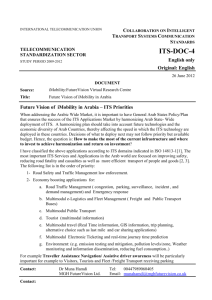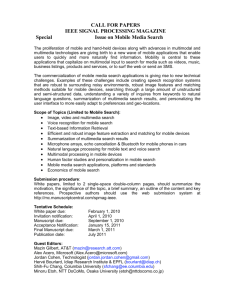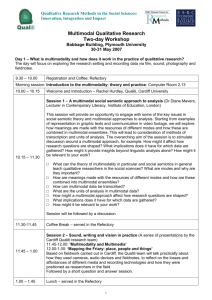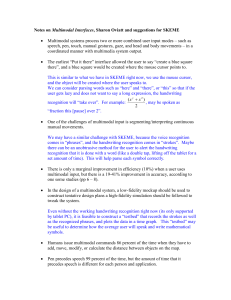Multimodal solution with Kirusa
advertisement
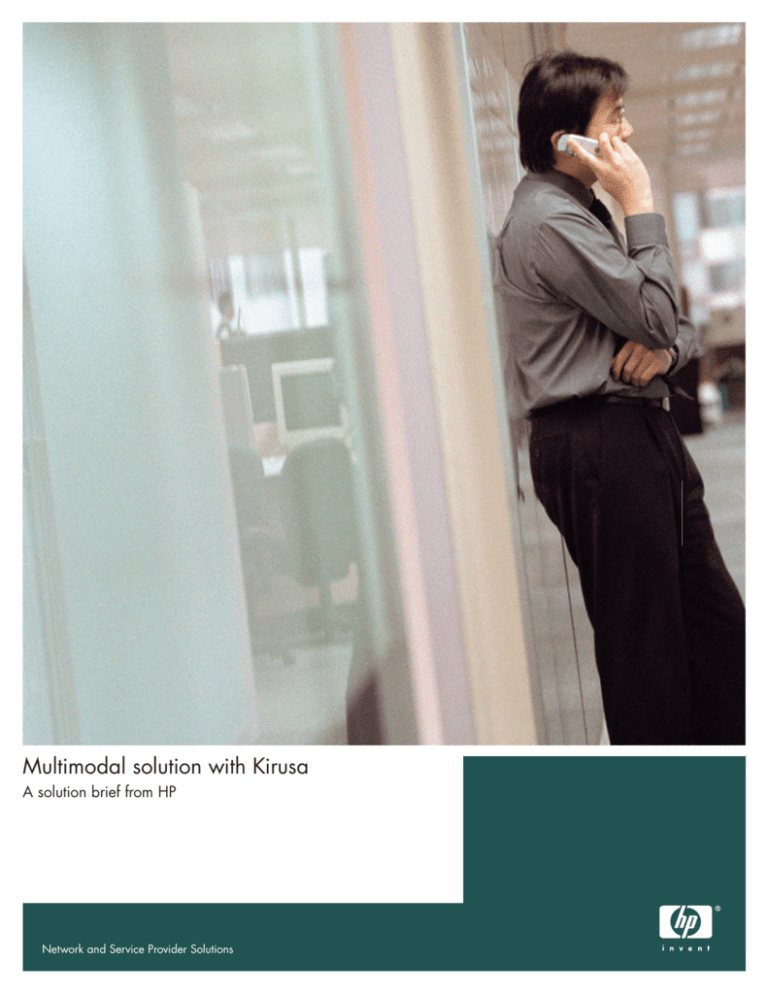
Multimodal solution with Kirusa A solution brief from HP Network and Service Provider Solutions Today’s mobile services are limited by user interfaces that allow for voice or visual interaction, rather than an integrated voice and visual interface. Usability problems unique to mobile devices have prevented operators from realizing a larger return on their service investments. Voice interfaces allow for simplified service input and interaction, but are not practical for conveying graphics or memory-straining information such as long lists, complex instructions or numbers. Conversely, Voice and visual interfaces for today’s mobile devices visual interfaces are cumbersome to use, but excellent for information output. By combining both voice and visual interfaces, applications can exploit the strengths of each and minimize the weaknesses of both modes. This integration, known as multimodality, seamlessly combines speech, text and touch input with graphics, text and audio output to deliver enhanced end-user mobile applications and services. Multimodality enhances service usability resulting in improved customer satisfaction and usage, while increasing revenues and reducing service provider churn. Multimodality gives end users the option to move from visual to voice mode and vice versa, or to use both modes simultaneously using a mobile device. For example, an end user might visually access e-mail using a mobile phone or PDA, but decide to respond to a message using voice. Likewise, the end-user might use voice to request directions to a specific destination but choose to retrieve a visual map to reach the final destination. Multimodal technology makes mobile devices and applications more user-friendly by allowing users to choose which mode is most appropriate for their specific circumstances. The HP Multimodal Solution, with Kirusa, is a carriergrade offering that provides network service providers with a complete multimodal solution comprising Kirusa’s multimodal client and platform, the HP OpenCall Media Platform (OCMP) deployed on carrier-grade server hardware, and devices, which may vary depending on the type of multimodal service a carrier would like to deploy. HP OCMP gives carriers the scalability, flexibility and investment protection they need for deploying enhanced voice services within the network. Together with Kirusa’s robust application environment, the HP OpenCall Media Platform ensures a multimodal solution that meets a carrier’s needs today, as well as accommodating future functionality and features. HP U/X servers, the number one choice for customers who demand quality, reliability, manageability and reasonable total cost of ownership (TCO) of their servers, power the HP Multimodal Solutions. Overview Kirusa has developed three forms of multimodality, simultaneous, sequential and Short Message Service (SMS). By offering each type, operators can offer multimodal services to their entire subscriber base, regardless of the technical capabilities of their mobile device. Simultaneous multimodality, where the device has both modes active, empowers the user to use voice and visual communication simultaneously. For example, in a mapping situation, a user can point to a street on the map and say, “Plan route, avoiding this street.” In a retail banking application, with “from account,” “to account,” and “amount” boxes on the screen, the user may simply speak “Transfer $5000 from account 123 to account 456,” and all three form entry boxes will be populated correctly as a result of speech commands. Results can be delivered in voice mode, visual or both, giving positive confirmation of the transaction. Simultaneous multimodality is available for wirelessly enabled personal digital assistant (PDA) and Smart Phone devices, which use the PocketPC operating system, Microsoft® SmartPhone architecture, or Symbian operating system. Sequential multimodality allows users to move between visual and voice modes, and offers real value when different steps of a single application are more effective or efficient in one mode than the other. For example, in a navigation application, it may be easier to speak the name of the place (voice mode) than to type it, yet it may be preferable to view a map (visual mode) than to listen to directions that may involve a half dozen turns. The swap between visual and voice modes may be initiated by the application or by the user. This type of service is available on wireless application protocol (WAP) phones, in addition to those devices mentioned for simultaneous service. SMS multimodality allows users to leverage SMS as the compelling visual component of a multimodal application. Imagine asking in voice for three-star hotels within one mile of Paris’ Porte Maillot district, seeing that list in a SMS message and asking in voice for more information about a selected property. This service type is available on any phone supporting short messages. Deployed in the customer’s network, the HP Multimodal Solution, with Kirusa, connects to both the customer’s voice and data networks to perform multimodal delivery. The platform functions as a gateway between each environment to enhance services. The solution supports all major mobile networks, including global system for mobile communications (GSM), general packet radio service (GPRS), universal 2 Kirusa Product Architecture Voice Network Speech Resources (ASR/TTS) Multimodal Application Provider (1) Voice XML/MRCP Kirusa Platform (KMMP) Multimodal Markup Data Network Kirusa Simultaneous Multimodal Client HP Hardware/ Enabling Software Multimodal Application Provider (2) Wireless Infrastructure Kirusa Multimodal Platform (KMMP) WAP Interface DB Interface Voice Browser Interface/Speech Interface User Database Simultaneous Module (Client Handler) Device Database Sequential Module SMS Module Markup Content Handler (X+V, SALT, M3L) GGSN/IWF Interface SMS-C Interface Billing Interface mobile telecommunications system (UMTS), code division multiple access (CDMA) One/1x/3x, 802.11x, integrated digital enhanced network (iDEN) and others. Kirusa Multimodal Platform (KMMP) is backwards compatible with 2G networks, handles the broadest array of devices in the industry and supports emerging multimodal standards such as speech applications language tags (SALT) and X+V (XHTML+VoiceXML). HP and Kirusa can multimodalize existing carrier applications by wrapping today’s popular standards, such as wireless markup language (WML), SMS, voice extensible markup language (VoiceXML) and hypertext markup language (HTML), in simple extensible markup language (XML)-based multimodal markup languages. For operators wishing to create their own services, Kirusa supports a development environment that simplifies service development by shielding the enormous complexity of multiple network protocols such as GSM, time division multiple access (TDMA), CDMA, GPRS and UMTS from the developer. No specialized wireless knowledge is required to develop multimodal applications, making it much easier and less expensive for operators to create new applications on their own. The Kirusa Multimodal Platform is tightly integrated with HP OpenCall Media Platform, the industry’s only carrier-grade, software-based media platform that scales from tens to thousands of ports for the interactive voice market. It offers an open, highly scalable, easy-to-manage, Multimodal Engine (State Manager) carrier-grade media platform for multimodal applications. The application and HP OpenCall-enabling software are deployed on carrier-grade HP hardware, and delivered and supported by HP Services. The service developed on the Kirusa Multimodal Platform integrates easily into network and operational support/ business support system (OSS/BSS) environments by using existing network capabilities such as GPRS, WAP and/or SMS. Kirusa does not require specialized support by the operator, network changes or new carrier network equipment and/or services. Benefits • Enables new applications, improves the usability of existing applications and broadens the scope of mobile applications. • Simple-to-use multimodal services drive subscriber service usage, increasing revenues. • Multimodal services power faster return on investment. • Existing services can be integrated and enhanced with multimodal platform. • Various multimodal offerings (simultaneous, sequential, and SMS) enable service providers to address their entire subscriber base. • Development environment allows for simple and efficient service creation. 3 Features HP advantage • Extensive device support, with a form of multimodality suitable for every user and device. Communications solutions are highly complex, and service providers must deliver even more innovative services to the market while keeping customers loyal and insulated from the complexities behind the services. In order to achieve this, service providers need strategic partners who can do more. HP offers a range of targeted, seamless solutions, integrated with partners, delivered quickly and efficiently. HP systems and solutions are open and flexible, empowering customers to customize or create value-added services. Our service capabilities provide the expertise to develop, integrate, test, install and support the most complex service launches. This one-stop shopping approach lets service providers focus on their customers—not their suppliers. • Use of well-known, high-level languages such as HTML, VoiceXML, SALT, XML, and WML enables faster creation of applications and eliminates the need for developers to have specialized wireless or device knowledge. This allows service providers to leverage a larger development community. • Supports the two emerging multimodal standards, SALT and X+V, effectively future-proofing technology investment. Partners Kirusa, Inc. is a multimodal infrastructure company that develops industry-leading multimodal technology (with several patents pending) for the delivery of voice and visual applications. This next generation of wireless technology allows users to customize the presentation of information on wireless devices by either alternating, or simultaneously receiving data through visual and voice interfaces. The company is headquartered in Edison, New Jersey, and has been founded by telecom and Internet industry veterans from leading telecommunications organizations. HP focuses more than 25 years of expertise into a powerful integrated team, the Network Service Provider Business Unit (NSPBU). The NSPBU, along with 500 valued solutions partners, assists the world’s top 200 service and equipment providers, as well as media, entertainment and cable operators, in meeting their subscriber needs. With solutions, technologies and services including: HP OpenCall and HP OpenView telecommunication capabilities arrayed across network infrastructure, network services, operations and business support, mobile and rich-media solutions, and end-user access, the HP NSPBU is a major player that is leading change in the network and service provider industry. For more information, go to www.hp.com/communications September 2003. © 2003 Hewlett-Packard Development Company, L.P. The information contained herein is subject to change without notice. The only warranties for HP products and services are set forth in the express warranty statements accompanying such products and services. Nothing herein should be construed as constituting an additional warranty. HP shall not be liable for technical or editorial errors or omissions contained herein. Microsoft is a U.S. registered trademarks of Microsoft Corporation. Printed in the U.S.A. 09.2003 P/N 5982-1542EN

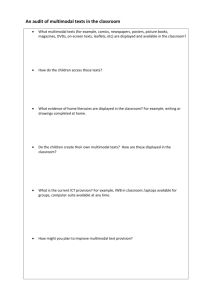
![Multimodal evidence of learning [DOC 45KB]](http://s3.studylib.net/store/data/007666677_2-5d54082e6a18fa7c91ee543af4725a90-300x300.png)
